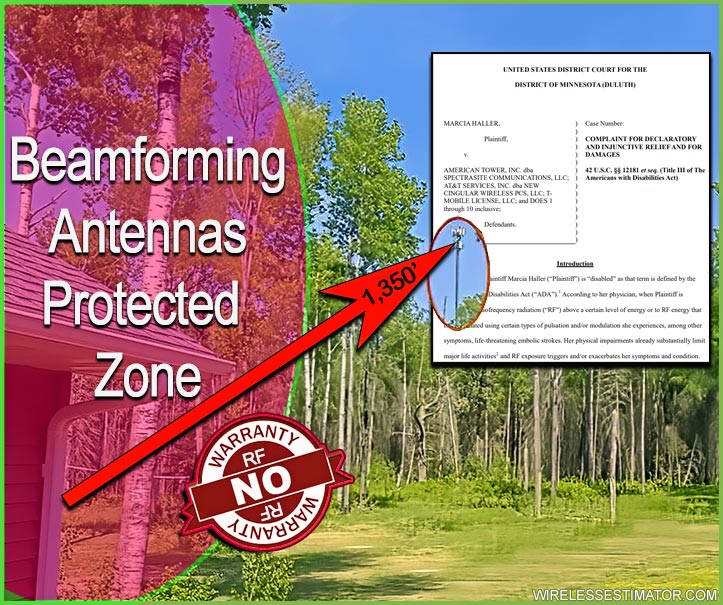
THE RAMIFICATIONS WOULD SET BACK BROADBAND INITIATIVES if a jury sided with Marcia Haller and required carriers to beamform around homeowners who state they suffer from RF sensitivity. Even if AT&T and T-Mobile could quarantine RF around Haller’s Minnesota residence, they could never warrant that there would not be RF leakage. The defendants are expected to file a motion to dismiss Haller’s lawsuit within the next few weeks.
After American Tower, AT&T, and T-Mobile did not respond by February 1, 2024, to Duluth, Minnesota resident Marcia Haller’s request to mitigate RF levels that continued to make her ill at her home (as detailed on February 29, 2024, by Wireless Estimator), and caused 51 strokes, her attorneys, being paid by the Children’s Health Defense’s Electromagnetic Radiator & Wireless program, filed a lawsuit on Monday.
Under Haller’s American With Disabilities complaint, she claims that the defendants “could easily and with minimal cost” take action to modify their RF signals so that she can still take advantage of their services while suffering from her current debilitating electromagnetic sensitivity issues.
Although the lawsuit states that there are “many practically feasible options to modify (RF) without materially reducing defendants’ ability to provide service to the rest of the public, such as reorienting antennas and/or taking advantage of newer antennas to beamform,” they may not find beamform antennas that will ensure that the Haller property is quarantined.
Complete isolation in the strictest sense, meaning no RF signal leakage outside the targeted area, is challenging due to the nature of RF propagation. Signals can diffract around obstacles, such as the acres of tall trees in and around the Haller property, reflect off surfaces, and scatter in various directions, leading to some degree of signal spread beyond the intended area.
The lawsuit acknowledges this possibility, citing an ADA statement regarding physical obstructions in their technical manual: “If the barrier removable is not readily achievable, then Defendants must provide access through other means, even if they are not the most integrated settings appropriate.”
The defendants’ reply to the complaint will likely not address these statements. Still, they will file a motion to dismiss them based on the safety of RF transmissions in and around the site, especially at the Haller residence.
Although Haller’s January 18, 2024, pre-lawsuit correspondence to the plaintiffs discussed the levels of RF measurements a consultant took, this week’s more detailed complaint did not include that background. This is possible because, as RF subject matter expert Lawrence Behr pointed out, the findings were questionable. It would benefit the defendants if the plaintiff offered the study and provided any exploratory data before the court.
If a court order found unlawful discrimination against Haller based on her pre-existing self-described disability and required the carriers to reduce or eliminate transmissions as an acceptable modification or accommodation on her property, an adjoining neighbor whose home is 200 feet from Haller’s property could be adversely affected.
The lawsuit states, “At present, Plaintiff cannot use Defendants’ goods, services, facilities, privileges, advantages, or accommodations because doing so triggers severe and potentially life-threatening symptoms.”
However, Haller does use wireless services. While preparing to take test readings for his 57-page EMF assessment report for the Haller residence issued June 2, 2023, Frank DiCristina, a building biologist and dowsing practitioner with no known legal or professional standing in the US, said he identified some networks in the immediate area, and he had turned off his cell phone and said, “I had Marcia Haller turn off or put her phone into airplane mode as well.”
The lawsuit provides questionable and incorrect statements regarding a possible fix for Haller’s problem. “The Tower is unpopular in the rural Gnesen community, which already had communications capabilities (including internet access) that do not depend on the Tower or Antennas. Moreover, Gnesen has received grants for wired broadband (high speed internet) and is beginning construction of the same in Summer 2024, which further renders the Tower and Antennas unnecessary for broadband delivered to residences,” the complaint states.
The 295-foot tower was approved for construction before Haller purchased her property and was erected in 2008, providing mobile coverage that was finally made available to Haller and her surrounding rural neighbors. It was when AT&T and T-Mobile upgraded their network to 5G around 2019 and 2020 that Haller said she had her strokes and other illnesses that required her now to sleep with her husband in a Faraday cage in their stand-alone garage.
The lawsuit’s statement: “The Tower and Antennas are primarily for wireless-based video streaming—which is more lucrative than video delivery on a wired basis but also far less efficient and more destructive,” is unsupportable.
The defendants have 21 days to answer the lawsuit following receipt of the complaint.
One of the most publicized incidents regarding residents claiming they were suffering from illnesses caused by 5G occurred in 2022. The Pittsfield, Massachusetts, Board of Health issued an emergency cease-and-desist order directing Verizon to shut down its tower because it was “a public nuisance” and “cause of sickness” that renders dwellings unfit for human habitation.
Verizon sued the city in federal court, contending that the residents’ medical complaints were bogus and that federal law gave the FCC the sole power to regulate wireless radiation risks. Not wanting to fund an extensive fight, the city backed down and withdrew its order.
















